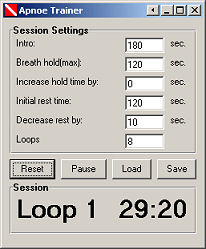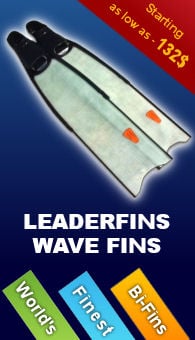Static Tables
As already mentioned in chapter A, high level of carbon dioxide causes the urge to breathe. If so, in order to prolong the duration of freediving, we must accustom our body to high levels of carbon dioxide (CO2) and to low levels of oxygen (O2). Accustoming the body to these extreme conditions is a long process, noticeable results will not appear within days or even weeks - however persistence in static training will lead to dramatic improvement in the long run. Static tables are actually sequences of timed static breath holds (with no movement during the breath hold) - designed to accustom the body to the extreme conditions of lack of oxygen or excess carbon dioxide. The tables can be performed in water or on the surface. In order to begin training static tables, you must first be aware of your personal best because both types of tables (CO2 and O2) are based on it - meaning - the first practice session will be dedicated to performing a maximum breath hold, It is recommended to perform several warm up breath holds before attempting to perform the maximum breath hold. The personal best should be monitored once in 2 months and the tables should be adjusted accordingly.
Attention! Violation of the table limits may cause permanent damage to the respiratory system, do not practice more then one table per day ! Never exceed eight cycles within one table and always practice with a buddy who is completely aware of what you are doing. Practicing static tables may lead to an LMC or even a black out.
CO2 Tolerance Table
The following static table is designed to accustom the body to high levels of carbon dioxide by reducing the duration of resting time between fixed breath hold periods. The duration of the timed breath hold should not exceed 50% of your personal best and the table should consist of no more then 8 cycles. The following table consists of 8 cycles and is based on a personal best of 3 minutes;
rest - 2:30 min ; hold - 1:30 min
rest - 2:15 min ; hold - 1:30 min
rest - 2:00 min ; hold - 1:30 min
rest - 1:45 min ; hold - 1:30 min
rest - 1:30 min ; hold - 1:30 min
rest - 1:15 min ; hold - 1:30 min
rest - 1:00 min ; hold - 1:30 min
rest - 1:00 min ; hold - 1:30 min
Total duration 25:15 min
This table can be adjusted to your ability by changing the breath hold duration to 50% of your personal best or by reducing/prolonging the duration of the initial resting period.
Goals
1) Reduce the duration of the initial and final resting periods while maintaining a fixed breath hold duration.
2) Prolong the duration of the fixed breath hold while maintaining the same duration for resting periods.
3) Prolong the duration of the fixed breath hold while reducing the duration of the initial resting period.
O2 Tolerance Table
The following static table is designed to accustom the body to extremely low levels of oxygen by prolonging the duration of breath holds between fixed resting periods. The duration of the last breath hold in this table should not exceed 80% of your personal best and the table should consist of no more then 8 cycles. The following table consists of 8 cycles and is based on a personal best of 3 minutes;
rest - 2:00 min ; hold - 1:00 min
rest - 2:00 min ; hold - 1:15 min
rest - 2:00 min ; hold - 1:30 min
rest - 2:00 min ; hold - 1:45 min
rest - 2:00 min ; hold - 2:00 min
rest - 2:00 min ; hold - 2:15 min
rest - 2:00 min ; hold - 2:30 min
rest - 2:00 min ; hold - 2:30 min
Total duration 30:45 min
This table can be adjusted to your ability by changing the maximum breath hold duration to 80% of your personal best or by reducing/prolonging the duration of resting periods between breath holds.
Goals
1) Reduce the duration of the fixed resting period while maintaining the same duration for breath holds.
2) Prolong the duration of the initial breath hold while maintaining the same duration for resting periods.
3) prolong the duration of the initial breath hold while reducing the duration of the fixed resting period.
Important
It is recommended to perform between two to four tables per week - one at a time - Never perform both types of table during the same day.
Static Table Training Software
"ApnoeTrainer" is a software designed to calculate and build static tables for O2 and CO2 tolerance. It also "plays" the table in real time and acts as a guide while playing it - it performs a vocal countdown before each breath hold and informs the user when a resting period begins. It is a freeware and is free of adware and spyware. Click here to download.
Wednesday, March 26, 2008
Training - Static Tables
Subscribe to:
Post Comments (Atom)








Thanks, this post was a great help and it's exactly what I needed. The included program is ace!!
ReplyDeleteHi, I was doing some static apnea training on my couch last night and lost consciousness somewhere after 4 minutes. Its the first time this has happened to me. I was wondering how common things like this are with other people practicing static apnea. Also how dangerous is it to go unconscious when your not in the water?
ReplyDeleteThis comment has been removed by the author.
ReplyDelete@Charlie On land it is not dangerous to BO (although there are certainly no benefit to pushing yourself to BO). As you experienced, you started to breathe again and you are fine. You'd have to be not breathing for over 4 miin after BO to be worried, but it wouldn't happen when practicing dry ... btw, I got this info from a medical doctor specializing in sport injuries, it's not just my opinion. Dive safely !
ReplyDeleteIf my best time is only 90seconds, should I halve the rest times as well as the breath-holding times?
ReplyDeleteYou can, but you don't HAVE to.
ReplyDeleteHi i have the ap on my phone and will be trying to train for better dives when spearfishing. I would like to know about practice. Is it not reomended to do both tables? Even if you do one in the morning and one in the evening?
ReplyDeleteYou could do both tables in one day, but its not a good idea for the long run (always performing 2 tables) as these tables strain your body and mind.
DeleteI recon doing 1 table per day, adjusting the times as you progress, 3-4 times a week is a great plan for the long run.
Hi thanks for the help. I guess i'll stick to one table a day :)
DeleteAre the costly nose clips worth the price over the plastic ones? If so, why are they not sold in the US?
ReplyDeleteUmm... which costly nose clips? :-)
DeleteThe consensus among freedivers is that the best nose clip for freeidivng is the Paradisia nose clip (http://paradisia.chez.com/english.htm)
I got a couple of these and they work great!
This apnoe trainer works not correct for O2 training. The problem is in a hold countdown.
ReplyDeletei see u write "do not practice more then one table per day" does this mean i shouldent go out free diving same day as i do a table?
ReplyDeleteYou can definitely go out free diving the same day, but you shouldn't exercise more than one table in a single day as these tables can be very straining mentally.
Deletebut doing free diving is not equivalent to a table?
ReplyDeleteIt's not as mentally straining as performing a table.
DeleteHi
ReplyDeleteI have dowload the trainer any explanation on how to use it?
Well, please read the above article. and you will see that its pretty much self explanatory :-)
DeleteIf you have a specific questions - please don't hesitate to ask.
So I am having a problem when I use the Increase hold time by. It is not working correctly.
ReplyDeletedetails? :-)
DeleteWhat are you trying to do, and is not working for you?
which means sima train in a table, or something you can use that name (table) that you are dialoguing, because I'm not intendendo which means table!
ReplyDeleteLol. Stupid brazilian people... Não to intendendo. Hahaha
DeleteHello,
ReplyDeleteWhat should the correct breathing pattern be while doing the static tables? For example, inhale for 4 seconds, exhale for 8 seconds?
Thanks,
I have a similar question. During the resting phase is it preferable to do focused breathing or just breath normally?
ReplyDeleteAnd in terms of adjusting the tables one can lower the resting time or increase the bh. Is one preferable over the other?
I also have a mac and can't seem to get the trainer program to work.
Thanks.
During the rest period; first you will have to take some recovery breaths the recover from the breath hold, and then begin your preparation for the next breath hold, so "breathing normally" isn't really a part of the rest period between breath holds.
DeleteRegarding adjustment of the tables; the rule of thumb is that breath holds should not exceed 50% of your personal best for CO2 tables or 80% of your personal best for O2 and the table should consist of no more then 8 cycles.
Hello, If I want to create my own table with my maximum, can I simply divide all numbers by a fixed ratio,or are some variables "constants" or so?
ReplyDeleteCan the program used with mixed type training?
ReplyDeleteTo reduce the resting period and combine this with increased time holding the breath?
Yes, it is possible, however for best results, it is recommended to work on CO2 and O2 tolerance separately
DeleteWich one i supose to do first? O2 , co2?
ReplyDeleteWhich ever you like :-)
DeleteThere's no required or recommended order, but I'd advise against doing both types of table on the same day.
Mahalo for your clear instructions and excellent advice!
ReplyDeleteDuring the ventilate periods in a table should I breathe normally, deeper than normally, take several large breaths just before the apnea?
ReplyDeleteIn the times between dives you should begin with recovery breaths. Once you are in control of your breathing begin preparation breathing for the next breath hold.
DeleteThank you for your reply. By recovery breaths I assume you mean steady, deep controlled breaths until I am able to 'forget' breathing and breathe naturally? The preparation breathing - how would you advise I do this? By breathing faster, deeper, or exhaling more?
DeletePreparation breathing - try to follow the guidelines in our "Preparation for Water" guide: http://freedivingexplained.blogspot.co.il/2008/03/basics-of-freediving-preparation-for.html
DeleteRegarding the rhythm of preparation breathing, this is a very subjective matter; so long as you stick to the breathing guidelines, this is really up to you. Some simple trial and error will let you know which rhythm works best for you.
Thank you!
DeleteIf my best holding time is 4 min at sea level and 3 min on 2000 m altitude, which value should be the base for static trainings at 2000 m altitude? Thanks for your great blog.
ReplyDeleteSince your best performance decreases by 25% in these conditions, it's probably best to adjust your breath holds during training respectively (decrease by 25%).
DeleteI started doing tables at the beginning of this year. I started at a quite low time, a PB of less than a minute. That quickly improved to 1:50 by the end of January. Since then I have not improved. In fact, doing any given table has been getting harder and harder to the point where I needed to drop the hold times just to be able to complete a table. If I try and push really hard to complete a table, I end up feeling terrible for the rest of the day.
ReplyDeleteWhat's going on? What should I be doing?
Notes: 1 table a day, 4 days a week, CO2 at 50% of PB, O2 at 40% to 75% of PB. Last sessions used a PB of 1:40.
Breath holding is a largely psychological sport and from your description it sounds like you may have been over-training yourself.
DeleteTry and take a complete break from training for at least 2-3 weeks. Then begin your training again with 2 or 3 (at most) tables per week.
Remember, improvement never comes in/during training, but during the rest periods between training sessions - make sure to allow your body and mind to rest properly between training and don't over do it!
OK, new plan: Wait for May, do one CO2 and one O2 table per week, not on consecutive days.
DeleteBefore things regressed, completing a table was easy, with little no strain at all. Is that the way it should be?
My goal: When on a snorkeling trip, if I see something I want to photo, I can inhale, swim down, take the shot, look and swim around a bit, and surface. All while I want to feel comfortable. Note that this would be a "shot of opportunity", so there would have been no warmup, or even a breath-up, beforehand. Is that realistic?
Can anyone please explain where the no more than 8 cycles comes from? It seems fairly arbitrary and I haven't stumbled on anything relating to physiology. Please if anyone knows otherwise let me know?
ReplyDeleteUpdate on my training: Since May I've been doing two tables a week. My PB time has continued to decline, and is now in the 1:10 to 1:20 range. Sessions are not getting easier, but harder. What's going on? What should I be doing?
ReplyDeleteMy doctor says there is nothing wrong medically, and is actually pleased with how my breathing (Spirometer test) has improved.
Hi, personalo Best must be with or without good ventilation before holding it?
ReplyDeleteMerman, are you doing it before meal? Eating is bad for breathing holding. But I think you know that.
I do my personal best times with good ventilation.
DeleteI delay my meals until after a training session.
I have a breath hold of 4.5 minutes in my home. When I get in the water and am actve I am about 30-40 seconds. Any tips on extending my water times?
ReplyDeleteWell, the trick is staying as inactive as possible during your dives; also work on staying relaxed while submerged in water - practicing static tables in the pool may be beneficial.
DeleteWhy is 8 the magic number of cycles?
ReplyDelete